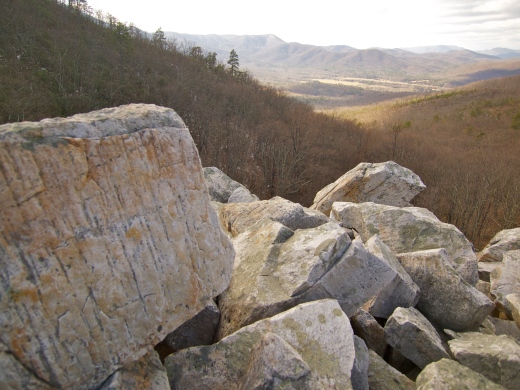Wow, just wow. This is a pretty stunning place. Devils Marbleyard is not marble but is a devilish jumble of rocks. I'm doing an 8.3 mile loop hike to visit the boulder field. Beginning at a small parking area at the entrance to Camp Powhatan, a boy scout camp now in ruins, I begin in chilly weather. The Belfast Trail takes me about a mile and a half to the beginning of the rock jumble. As I approach, I see what looks like smoke. As I draw closer. I realize it is not smoke. It is this pile of gray rocks.
I parked beside this bridge which led the way to the camp entrance.
The camp which opened in the 1930s, now lays in ruins. There are many stone foundations and trails here.
Shortly after passing the old camp you enter the wilderness. It is a very rocky uphill trail that leads to the boulder field.
This is my first glimpse of the boulder field. My first thought was a glacier deposited these rocks. It reminds me of the erratic rocks of southern Connecticut, my home as a youngster. Of course that is not how they got here. One of my favorite bloggers, Mary Caperton Morton writes in her fabulous blog-Travels with the Blond Coyote:
So what happened here? As it turns out, the bizarre and beautiful geology of the Devil’s Marbleyard tells a story of ancient beaches, extinct worms, supercontinents and ice crystals. According to the U.S. Geologic Survey, the white rocks of the Marbleyard began as a white sand beach, much like the Outer Banks of North Carolina, around 500 million years ago. The sand was riddled with worms, which left behind copious worm-track tunnels as they moved through the sediment.
Over a period of several hundred million years, the beach was buried and the quartz-rich sediments were compressed and baked into quartzite, one of the hardest metamorphic rocks on the planet. A few of the worm tracks were preserved, all in one parallel plane; tracks in other orientations were obliterated.

Looking back down into the Natural Bridge valley, worm tracks on the left. This rock is classified by the USGS as Antietam Quartzite.
Then around 325 million years ago, the continental plate under what is now North America (then known as Euramerica) began colliding with the African plate (known as Gondwana), eventually forming the supercontinent Pangaea and pushing up the Appalachian Mountain chain to Himalayan heights.
For more than 200 million years, the hard quartzite of the Marbleyard lay intact, within the bowels of the mountains, until it was eroded to the surface, largely still in one piece. Then, ice went to work on the rocks, but not in the spectacular glacier-driven methods I imagined. Instead, tiny ice crystals found their way into cracks and fissures in the rocks, perhaps along the ancient worm-trails, and when the ice expanded, it cracked the rocks. Eventually, the entire quartzite ridge tumbled downslope, creating the Devil’s Marbleyard.
The moral of this story: given enough geologic time, worms can bring down mountains!
If you want a more fanciful account of the rocks' origin, another blog I follow is Virginia Trail Guide by Christine and Adam:
In the local tale, this area was occupied by Native Americans and the land was supposedly very green and lush. There was a large stone altar at the top of this hill that was used for worship on full-moon nights. A white couple met the Native Americans and they were thought to be spirits since they looked so different than the local tribes. The couple said they were not spirits but they worshiped a higher power. They converted the Native Americans to Christianity. However, the next year brought about a great drought and the Native Americans felt the new God and the missionaries were to be held responsible. They burned the couple alive on the altar. As the flames reached high into the sky, a storm formed. Lightning struck down upon the altar and exploded the rock over the mountainside.

The trail approaches the boulder field straight on but moves to the right to follow the periphery of the field. You can enter the rocks at several places but it is a tough scramble to move about. I have read that snakes occupy this area as you might expect. The rocks are of many sizes with the largest being as large as my pick-up. Nothing grows here as I imagine the boulder field is quite deep. Judging depth from the transition area, I's hazard a wild guess that it could be 20 feet deep.
Eventually, the trail deviates lower and away from the rocks into a ravine. So, I did not get to see the top of the boulder field.
The trail becomes less rocky and eventually ends at the AT. To the right (southbound) it is about a mile to "the helicopter pad", an open area with spectacular 360 degree views. However, recent trail comments indicate this area has overgrown and is no longer a scenic spot. So, I turn left and go northbound.
This is a ridge walk for a mile or more before heading downhill with 14 switchbacks. It is easy to see this on a map or gps track. The trail is fabulous with several viewing areas. It was loaded with a couple varieties of Azalea, Dog Hobble, Iris, Gay Wings and Birdsfoot Violets.
The last 3 miles of my hike were on the Glendale Horse Trail. It was a wide two track, so a boring ending to an otherwise spectacular hike.



















No comments:
Post a Comment